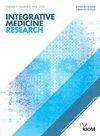Therapeutic effects of Gunryeong-tang on the cardio-renal axis in an animal model of pulmonary hypertension
IF 3
4区 医学
Q2 INTEGRATIVE & COMPLEMENTARY MEDICINE
引用次数: 0
Abstract
Background: In the realm of cardiovascular and renal health, the modulation of oxidative stress and inflammation within the cardio-renal axis plays a pivotal role. This study investigates the therapeutic potential of Gunryeong-tang (GRT), a traditional Korean herbal formula combining Oryeongsan (Wulingsan) and Sagunza-tang (Sijunzi-tang), specifically in addressing cardio-renal axis dysfunction induced by pulmonary arterial hypertension (PAH-r). Methods: PAH-r models were induced through intraperitoneal injection of monocrotaline (MCT) at a daily dose of 50 mg/kg for 5 days to simulate pulmonary hypertension, a common cause of cardio-renal syndrome. The primary focus is on evaluating its anti-fibroinflammatory effects and its ability to modulate oxidative stress and inflammation. The treatment group received oral administration of GRT (100 mg/kg/day). Results: Various parameters were assessed, including right ventricular (RV) enlargement and fibrosis, lung weight, pulmonary fibrosis, expression of cardiac hypertrophy markers, and involvement of specific pathways (TGF-β/p-Smad2 and HMGB-1/TLR4/MyD88/NF-κB). Renal dysfunction markers, such as blood urea nitrogen (BUN), creatinine clearance rate (Ccr), glomerular dilatation, tubular fibrosis, and protein expression of kidney injury molecule-1 (KIM-1) and neutrophil gelatinase-associated lipocalin (NGAL), were evaluated to highlight the formula's anti-fibroinflammatory effects. Treatment resulted in significant improvements in the PAH-r group. It alleviated RV enlargement and fibrosis, suppressed lung weight increase, and mitigated pulmonary fibrosis. The administration downregulated cardiac hypertrophy markers (CTGF, TGF-β, and α-SMA mRNA levels) and inhibited the TGF-β/p-Smad2 and HMGB-1/TLR4/MyD88/NF-κB pathways, showcasing GRT's anti-fibroinflammatory properties. Additionally, the treatment ameliorated renal dysfunction, as evidenced by reduced BUN and Ccr levels, improved glomerular dilatation, and reduced protein expression of KIM-1 and NGAL. GRT demonstrates significant therapeutic potential in managing cardio-renal axis dysfunction induced by PAH-r, emphasizing its multifaceted benefits in modulating oxidative stress and inflammation within this axis. Conclusions: This study provides valuable insights into the underlying mechanisms, highlighting the modulation of cardiac hypertrophy markers and specific pathways. These findings underscore the promising role of GRT as a viable treatment option for cardio-renal axis dysfunction associated with PAH-r.
健灵汤对肺动脉高压动物模型心肾轴的治疗作用
背景:在心血管和肾脏健康领域,心肾轴氧化应激和炎症的调节起着关键作用。本研究探讨了由五灵山(武陵山)和四君子汤(四君子汤)组合而成的韩国传统中药健灵汤(GRT)对肺动脉高压(PAH-r)所致心肾轴功能障碍的治疗潜力。方法:采用日剂量50 mg/kg的MCT腹腔注射诱导PAH-r模型,连续5 d模拟肺动脉高压(心肾综合征的常见病因)。主要的重点是评估其抗纤维炎作用及其调节氧化应激和炎症的能力。治疗组给予口服GRT (100 mg/kg/d)。结果:对右心室(RV)增大和纤维化、肺重量、肺纤维化、心肌肥厚标志物的表达以及特定通路(TGF-β/p-Smad2和HMGB-1/TLR4/MyD88/NF-κB)的参与情况进行了评估。评估肾功能障碍标志物,如血尿素氮(BUN)、肌酐清除率(Ccr)、肾小球扩张、小管纤维化、肾损伤分子-1 (KIM-1)和中性粒细胞明胶酶相关脂钙蛋白(NGAL)的蛋白表达,以突出该配方的抗纤维炎作用。治疗后PAH-r组明显改善。减轻右心室增大和纤维化,抑制肺重量增加,减轻肺纤维化。下调心肌肥厚标志物(CTGF、TGF-β和α-SMA mRNA水平),抑制TGF-β/p-Smad2和HMGB-1/TLR4/MyD88/NF-κB通路,显示GRT的抗纤维炎症特性。此外,治疗改善肾功能,如降低BUN和Ccr水平,改善肾小球扩张,降低KIM-1和NGAL蛋白表达。GRT在治疗PAH-r诱导的心肾轴功能障碍方面显示出显著的治疗潜力,强调其在调节该轴的氧化应激和炎症方面的多方面益处。结论:这项研究为潜在的机制提供了有价值的见解,突出了心脏肥厚标志物和特定途径的调节。这些发现强调了GRT作为与PAH-r相关的心肾轴功能障碍的可行治疗选择的有希望的作用。
本文章由计算机程序翻译,如有差异,请以英文原文为准。
求助全文
约1分钟内获得全文
求助全文
来源期刊

Integrative Medicine Research
Medicine-Complementary and Alternative Medicine
CiteScore
6.50
自引率
2.90%
发文量
65
审稿时长
12 weeks
期刊介绍:
Integrative Medicine Research (IMR) is a quarterly, peer-reviewed journal focused on scientific research for integrative medicine including traditional medicine (emphasis on acupuncture and herbal medicine), complementary and alternative medicine, and systems medicine. The journal includes papers on basic research, clinical research, methodology, theory, computational analysis and modelling, topical reviews, medical history, education and policy based on physiology, pathology, diagnosis and the systems approach in the field of integrative medicine.
 求助内容:
求助内容: 应助结果提醒方式:
应助结果提醒方式:


